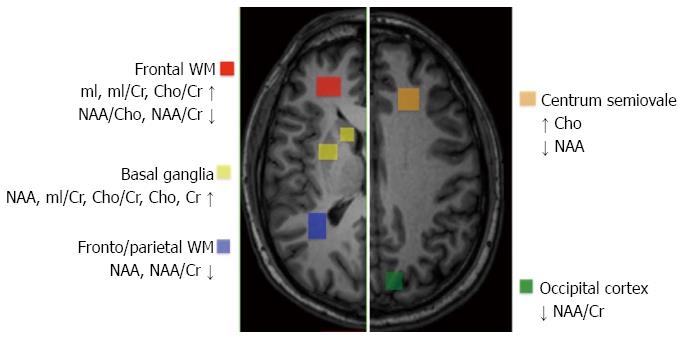Copyright
©The Author(s) 2015.
World J Gastroenterol. Nov 14, 2015; 21(42): 11974-11983
Published online Nov 14, 2015. doi: 10.3748/wjg.v21.i42.11974
Published online Nov 14, 2015. doi: 10.3748/wjg.v21.i42.11974
Figure 1 Summary of major extra-hepatic manifestations observed in patients with chronic hepatitis C virus infection.
Percentages of patients are represented in graphic form. The presence or absence of cryoglobulinemia is indicated by white and black, respectively. The most convincing associations of chronic hepatitis C virus (HCV) infection are with subsets of B-cell non-Hodgkin lymphoma (B-NHL), membranous or membrano-proliferative glomerulonephritis, IgM monoclonal gammopathy of undetermined significance (MGUS), peripheral neuropathy, and central nervous system (CNS) disorders.
Figure 2 Quantification and localization of brain metabolite concentrations in hepatitis C virus patients exhibiting neuropsychological and neurocognitive dysfunction.
The regional distribution of proton magnetic resonance spectroscopy (1H MRS) abnormalities suggests that only cortical and subcortical telencephalic areas, but not the thalamus or posterior fossa structures, are involved in hepatitis C virus (HCV)-associated neurocognitive disorder (HCV-AND).
- Citation: Monaco S, Mariotto S, Ferrari S, Calabrese M, Zanusso G, Gajofatto A, Sansonno D, Dammacco F. Hepatitis C virus-associated neurocognitive and neuropsychiatric disorders: Advances in 2015. World J Gastroenterol 2015; 21(42): 11974-11983
- URL: https://www.wjgnet.com/1007-9327/full/v21/i42/11974.htm
- DOI: https://dx.doi.org/10.3748/wjg.v21.i42.11974










